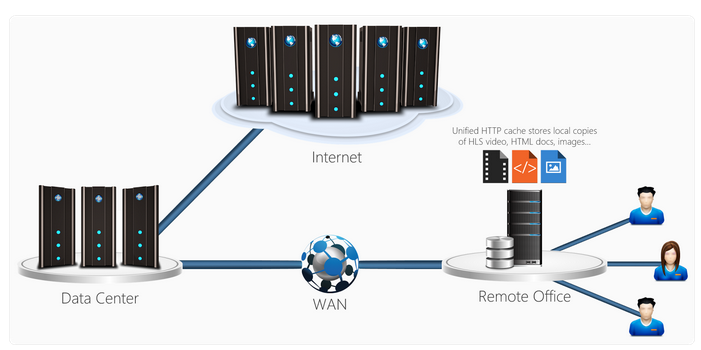- Enterprise IT/AV
7 Things That Define Modern Video Streaming
A seismic shift in video technology began in 2015. Legacy video streaming protocols built on overlay networks, custom protocols, and specialized servers began to give way to chunked, connectionless, HTTP-based “modern streaming.”
Organizations using modern video streaming software stand to reap the benefits:
- Reduced video infrastructure costs
- Simplified network management complexity
- Improved IT ecosystem scalability
- Enhanced video viewing experiences
For organizations with video infrastructure built on legacy streaming protocols, Modern Streaming represents an inflection point. Continued investment in legacy technology may limit near-term disruption — but it prolongs an inevitable transition, increases the eventual cost of switching, and limits the choice of technology providers who are actively divesting from the technologies.
An Overview of Modern Video Streaming
Shortly after the introduction of smooth streaming, modern HTTP-based video was put to the ultimate test. In August 2008, for the first time ever, every minute of every event of the Summer Olympic Games was streamed online in high definition. The event was delivered using Smooth Streaming through a partnership between NBC and Microsoft.
During the two weeks of competition, 50 million unique visitors initiated 70 million video streams and watched 10 million hours of video (an average of 27 minutes at a time). In a single event, “modern streaming” had proven that the internet was capable of scalable, reliable, broadcast-quality video.
 The 2008 Olympics opening ceremony kicked off 2,200 hours of online video streamed in a two-week period.
The 2008 Olympics opening ceremony kicked off 2,200 hours of online video streamed in a two-week period.
The success of the 2008 Olympics, and of HTTP streaming more broadly, was based on a simple but powerful architectural tenet: Modern Streaming fully embraced the topology of its underlying network. Unlike custom streaming protocols, which compete with the stateless, cache-friendly architecture of the internet and corporate WANs, HTTP streaming could leverage the architecture to deliver high-quality video at unprecedented scale.
Seven Characteristics Define Modern Streaming
What makes a video streaming protocol modern? Similarities across HLS, smooth streaming, HDS, and DASH yield seven common characteristics:
- Chunked delivery: With modern streaming, video files are divided into short multi-second segments that are sent across the wire. Depending on the protocol, the segments can range from 2-10 seconds in length. By contrast, custom streaming protocols treat videos as monolithic blobs of information.
- HTTP communication: Video segments are sent across the internet or corporate WAN using the standard HTTP protocol. Specifically, all modern streaming communications rely on TCP ports 80 (for unencrypted HTTP communication) and 443 (for SSL-encrypted communication).
- Stateless interaction: When a client is watching a video stream, each request for subsequent video segments is independent of previous requests. In other words, there’s no persistent connection between client and origin server during video playback.
- Cache-friendly: Chunked delivery is what enables modern streaming to work in concert with HTTP caches that are ubiquitous on the internet, in content delivery networks (CDNs), and in many corporate networks. This has major benefits for network bandwidth management and WAN optimization—topics discussed in greater detail below.
- Adaptive-bitrate (ABR) playback: Videos delivered using modern protocols are encoded at multiple quality levels. During playback, the client’s available bandwidth determines which quality level will provide the smoothest playback experience, and adjustments are made dynamically to minimize buffering while providing high-quality playback.
- Passive network architecture: When video fragments are in transit on the network, intermediary nodes simply route the fragments toward their final destination, and in some cases, also cache the fragment. The intermediaries never execute any specialized code or modify the video fragments.
- Internet-intranet symmetry: By default, modern protocols like HLS, DASH, Smooth, and HDS treat corporate WANs works no differently than the public internet. Both are passive, stateless networks comprised of hardware and software that can route video chunks to their final destination and cache video segments as needed.
Four Benefits of Modern Video Streaming
The seven characteristics of modern streaming define a video delivery model that doesn’t fit traditional categories of unicast, multicast, and broadcast. Instead, modern protocols simply put a sequence of short video segments on a server and allow any client to fetch them, either live or on-demand. What makes modern streaming unique is that there is actually very little unique about it. Modern protocols like HLS treat video files no differently than any other content being delivered across the network. In doing so, they homogenize the transport layer of all enterprise content to HTTP.
 Modern streaming unifies the network transport to HTTP, and provides a single, consistent caching infrastructure for improving the performance of video, images, documents, and other content.
Modern streaming unifies the network transport to HTTP, and provides a single, consistent caching infrastructure for improving the performance of video, images, documents, and other content.
When video is no longer a special-cased data type, IT organizations benefit from reduced management complexity, reduced cost, improved scalability, and improved playback experiences:
- Reduced management complexity
Modern Streaming enables organizations to consolidate video network traffic to HTTP using TCP ports 80 and 443. In doing so, it eliminates the need to deploy and manage a separate caching infrastructure. In addition, modern streaming can improve manageability at the edge of the network by helping video content traverse firewalls. In most corporate networks, some level of protocol and port restriction is used to minimize attack surface area. While ports 80 and 443 are almost always open for the flow of generic web traffic, this luxury isn’t always extended to RTMP, RTSP, and other legacy protocols. - Reduced costs
Custom streaming protocols drive up infrastructure costs in two ways. First, they require organizations to invest in server hardware and software that form the backbone of the “video overlay” network. Second, their inefficiency in caching content can increase the amount of bandwidth required to stream popular video across the network. Modern streaming overcomes both of these challenges. Protocols like HLS leverage the existing HTTP server network, enabling organizations to save costs that would otherwise be spent on specialized hardware and software. And as the use of video increases, HTTP caching proxies dramatically reduce the bandwidth costs associated with uncached video. - Improved scalability
The ubiquity of HTTP servers, and the protocol’s native support for mirroring and edge caching, make HTTP the ideal choice for streaming large-scale live events and frequently-accessed, on-demand content. When organizations invest in a modern protocol, scalability is an inherent benefit of the underlying network. By contrast, scalability with legacy protocols like RTMP is achieved only through additional investment in specialized hardware and software. - Improved playback
Modern streaming offers two benefits to the video playback experience. First, the use of HTTP and widely adopted codecs (e.g. H.264 for video and AAC for audio) helps ensure compatibility with a wide range of mobile devices. In addition, the use of adaptive bitrate streaming helps ensure that employees around the world get the best possible playback experience whether they’re at their desks on gigabit ethernet or in the field consuming media over a 4G network.
Learn More About Video Streaming
![]() In our latest white paper, Modern Video Streaming in the Enterprise: Protocols, Caching, and WAN Optimization, we’ll take a deeper look into the technical shifts driving the move toward modern streaming, including the seven characteristics that make a video streaming protocol modern.
In our latest white paper, Modern Video Streaming in the Enterprise: Protocols, Caching, and WAN Optimization, we’ll take a deeper look into the technical shifts driving the move toward modern streaming, including the seven characteristics that make a video streaming protocol modern.
We’ll also look that the new opportunities modern streaming presents for organizations to use existing network infrastructure for more scalable, cost-effective video delivery.




